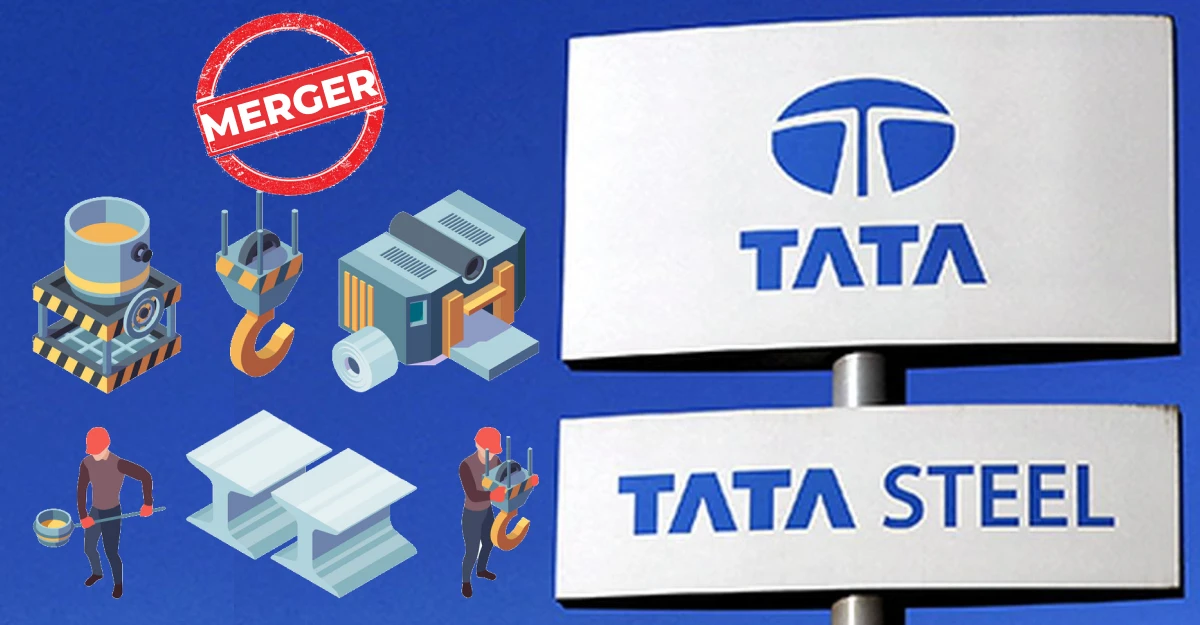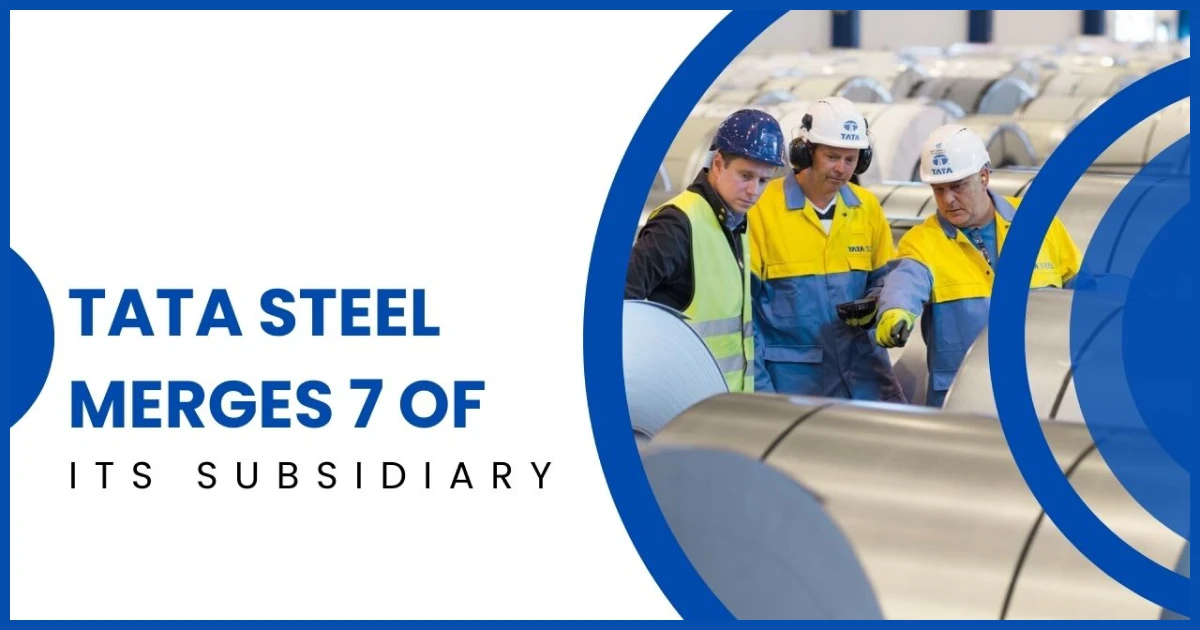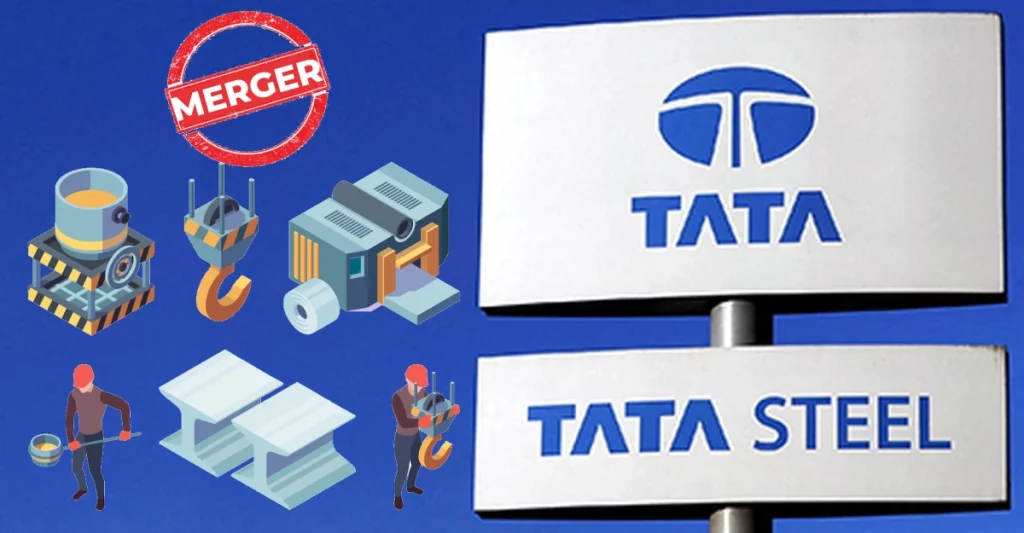Hey there! Remember Tata Steel’s catchy tagline from back in the ’90s – “We also make steel“? Well, guess what? They had been up to something big, i.e., the Tata Steel merger.

Yes! Tata had merged seven metal businesses to create a seriously robust and diverse entity called “One-Tata Steel.” It wasn’t just a business move; it was like they had been building a steel powerhouse.
Now, let’s break it down. This merger wasn’t just about Tata Steel getting bigger. It had been about changing the whole game in India.
Imagine the impact on jobs, the economy, and how India will be seen on the global stage. This move had been like a giant ripple in a pond, and we were here to figure out what it meant for you and everyone else.
So, buckle up as we explore how the Epic Tata Steel merger might just reshape the way things work around here!
(A) Tata Steel Merger: The Story So Far
So, last year, Tata Steel’s board gave the green light to bring together seven of its subsidiaries into the main gig-
- Tata Steel Long Products
- Tata Metaliks
- The Tinplate Company of India
- TRF Limited
- Indian Steel & Wire Products
- Tata Steel Mining
- S&T Mining
Now, why the big merger?
Well, Koushik Chatterjee, the CFO at Tata Steel, spilled the beans. He said it’s all about making things simpler to manage and putting a sharper focus on the core business. According to him, after successfully handling the integration of the larger and more complex Bhushan Steel, this move was the next logical step.

Back in 2018, Tata Steel, through its fully-owned buddy Bamnipal Steel Ltd (BNPL), snagged a controlling stake of 72.65% in Bhushan Steel Ltd (BSL) through an auction during an insolvency process.
Talking numbers, the company bigwig mentioned the net present value of synergies topping Rs. 1000 crore. That covers savings on costs, taking advantage of synergies in buying stuff and getting better at the whole money side of things.
But it’s not just about the numbers game. Tata Steel sees this merger as part of its ongoing mission to simplify how it holds its group together. Since 2019, they’ve been on a cleanup spree—116 associated entities gone, 72 subsidiaries dusted, 20 associates and joint ventures out, and 24 companies on the liquidation table.
Why?
Well, it’s all part of Tata Steel’s bigger plan.
This consolidation isn’t just a business move; it’s a strategy to give them more flexibility to turbocharge the growth of specific businesses in their lineup.
So, buckle up—you’re in for a ride as Tata Steel reshapes its game!
(B) Reasons for Tata Steel merger: Why is Tata Steel merging its subsidiaries?
Let’s go through the primary reasons for the Tata Steel merger in the following table-
| Reasons for Tata Steel Merger | Explanation |
| Majority Holding | Tata Steel holds the majority stake in the subsidiary companies. |
| Synergies | The merger aims to achieve greater synergies among the consolidated entities. |
| Efficiency | The proposed amalgamation is expected to reduce costs and improve operational efficiency. |
| Agility | Enhanced agility across businesses due to strong support from Tata Steel leadership. |
| Downstream Growth | Consolidation of downstream operations to drive growth in value-added segments. |
| Savings | Anticipated annual savings of Rs 750-800 crore, according to Kotak Securities. |
| Financial Benefits | Projected net present value of synergies exceeding Rs. 1000 crore. |
| Streamlined Management | The merger is intended to streamline management processes. |
Some Other Reasons
| Reasons | Details |
| Focus | Enhanced focus on the core business as a result of the consolidation. |
| Nationwide Network | Leveraging Tata Steel’s nationwide sales and marketing network for downstream growth. |
| Bhushan Integration | Following the successful integration of Bhushan Steel, a larger and more complex acquisition. |
| Group Structure | Aligns with Tata Steel’s ongoing strategy to simplify its group holding structure. |
| Flexibility | Provides greater flexibility for accelerated growth in specific businesses within the portfolio. |
| Financial Estimates | Kotak Securities estimates annual savings, equity dilution, and potential EPS accretion. |
| Timeline | The merger is expected to be completed by the end of FY24. |
| Systematic Reduction | Tata Steel has systematically reduced 116 associated entities since 2019. |
(C) When will the Tata Steel Merger happen?
So, you’re probably curious about how long these proposed transactions will take, right?
Well, it looks like it might take several quarters to get everything sorted. Before it becomes official, these mergers have to go through a regulatory approval process. That involves getting the nod from stock exchanges and the National Company Law Tribunal (NCLT).
Now, when’s this all going to be wrapped up?
The goal is to have everything completed by the end of the financial year 2023-24. So, yes, it’s a bit of a process, but they’re working on it, and it should be done by then.
(D) Analysts Opinions on the Potential Impact of Tata Steel Merger on India
Here comes the most anticipated part of the write-up. What kind of impact we will face due to the Tata Steel merger?
Go through the following table and you will find out!
| Source | Perspective/Impact of Tata Steel Merger | Rating/Target Price | Key Points |
| Fitch | Expects higher EBITDA through synergies, cautions on modest gains dependent on regulatory approvals. | N/A | Anticipates financial benefits but warns of potential delays |
| ICICI Direct | Stresses better synergies, operational improvements, and managerial efficiency. | N/A | Advocates a comprehensive approach to the merger. |
| JP Morgan | OVERWEIGHT rating, minimal impact on financials, customary market consideration of consolidated earnings. | OVERWEIGHT, ₹140 per share | Expects minimal financial impact, and emphasizes market norms. |
| Motilal Oswal | NEUTRAL rating, predicts no additional profits and anticipates savings on regulatory costs and process efficiencies. | NEUTRAL, ₹106 per share | Foresees no extra profits but identifies potential savings and process efficiencies. |
| Edelweiss Securities | HOLD rating foresees benefits like lower costs and synergies, and cautions about potential downsides related to shareholding dilution. | HOLD, ₹198.5 per share | Expects medium to long-term benefits but warns of potential downsides. |
The following points describe the opinion of the analysts on the impact of the merger-
Fitch’s Perspective
Now, let’s talk about what Fitch, the rating agency, has to say. According to them, the merger is expected to bring in higher EBITDA through procurement and marketing synergies, along with lower royalty payments. However, they caution that the financial gains might be on the smaller side and could take some time, depending on how quickly regulatory approvals come through.
ICICI Direct’s Analysis
Moving on to ICICI Direct’s insights. They believe the proposed amalgamation is all about creating better synergies among the involved entities. The scheme aims for operational integration, improved facility utilization, logistics cost rationalization, operationalized efficiency, a simplified structure, and better management efficiency. Quite a comprehensive approach, isn’t it?
JP Morgan’s View
Now, let’s consider JP Morgan’s stance. They’ve got an OVERWEIGHT rating with a target price of Rs 140 per share. Their take is that the consolidation’s impact on the company’s financials will be minimal. JP Morgan points out that markets and investors usually look at earnings and balance sheets on a consolidated basis, and all the subsidiaries are part of that bigger picture.
Motilal Oswal’s Analysis
Taking a look at Motilal Oswal’s perspective. They’ve maintained a “NEUTRAL” rating with a target price of Rs 106. According to them, don’t expect any additional profits for the group. However, there’s a silver lining – they predict savings on regulatory costs like iron ore royalty and other time-consuming compliance processes.
Edelweiss Securities’ Take
Last but not least, let’s check out what Edelweiss Securities has to say. They’re sticking with a “HOLD” rating on Tata Steel with a target price of Rs 198.5 per share. The key benefits they foresee over the medium to long term include lower royalty and iron ore costs, plus potential synergies.
However, they do caution that the incremental EBITDA benefits might get offset by shareholding dilution due to the amalgamation.
Quite a mixed bag, right?
(E) Understanding Tata Steel Merger Ratios: Impact on Listed Companies’ Shares
Alright, let’s break it down for you. After the merger, all the companies in the mix are going to disappear. But, here’s the deal for you as an investor in these listed companies – your compensation is coming in the form of Tata Steel shares, based on the share swap ratio.
Now, let’s get into the specifics-
- If you’re into Tata Steel Long Products: Get ready to receive 67 Tata Steel shares for every 10 of your Tata Steel Long Products shares.
- For TRF Investors: Tata Steel has set it at 17 Tata Steel shares for every 10 TRF shares you’ve got.
- Invested in The Tinplate Company: You’ll be getting 33 Tata Steel shares for every 10 of The Tinplate Company shares you hold.
- Tata Metaliks Shareholder: Brace yourself for 79 Tata Steel shares for every 10 Tata Metaliks shares in your possession.
So, there you have it – a glimpse into how the merger ratios might shape up for your shares.
Note: Do you know about another Tata strategic move where it is planning to buyback 20% of Tata Play from Temasek? If not, then visit the article on “Buyback of 20% of Tata Play” for detailed information.
(F) Are investors happy about the Tata Steel Merger?
Let’s dive into what’s going on with the Tata Steel merger and how investors are feeling about it.

So, if you’re a Tata Steel shareholder, you’re probably feeling pretty good about things. The stock has seen a solid surge, up to 4%, which is definitely a positive signal.
Now, on the flip side, if you’re invested in the other four companies involved in the merger – Tata Steel Long Products, Tinplate, TRF, and Tata Metaliks – it’s a bit of a different story. Unfortunately, their stocks have experienced declines of up to 10%, signaling a less enthusiastic response.
Now, let’s talk about the share swap ratios, a big deal in this merger game. Tata Steel is making sure its shareholders get favorable ratios, and that’s likely why the Tata Steel investors are feeling content. But, if you’re holding stocks in the subsidiaries, the dip in their values might not be making you as happy.
Analysts are throwing in their perspectives too. Some are pretty upbeat, talking about strategic direction and potential synergies coming out of this merger. On the flip side, there are others raising concerns about things like potential equity dilution and the whole process needing approvals from shareholders and regulators.
So, summing it up, there’s a mix of positive and not-so-happy reactions swirling around. Your take on all this likely depends on your own views, expectations, and how things unfold in the coming days with this Tata Steel merger. Keep an eye out for updates!
(G) Overall Impact of the Tata Steel Merger on India
The following table provides a concise summary of the potential impacts of the Tata Steel merger on various aspects within India-
| Aspects | Impact on India | Type of Impact |
| Economic Growth | Potential for increased economic efficiency and growth. | Positive Impact |
| Employment | Impact on jobs, both creation and potential losses. | Mixed Impact |
| Global Standing | Influences how India is perceived on the global stage. | Mixed Impact |
| Industry Competitiveness | Strengthening Tata Steel’s position in the industry. | Positive Impact |
| Market Dynamics | Effects on the stock market, especially for involved stocks. | Varied Impact |
| Regulatory Landscape | Potential changes in regulations within the sector. | Varied Impact |
| Investor Confidence | Varied reactions, impacting investor confidence. | Varied Impact |
| Technological Innovation | Potential for advancements in the merged entity. | Neutral Impact |
| Long-term Business Strategy | Alignment with Tata Steel’s strategic goals. | Positive Impact |
In understanding these impact terms, think of a positive impact as something that’s genuinely good, leading to improvements or growth. When we talk about a mixed impact, it means there’s a mix of good and not-so-good effects—some positives and some negatives.
Now, a varied impact suggests that the outcomes can differ based on who or what we’re looking at, introducing diversity into the picture. On the flip side, a neutral impact signals that not much has changed—neither for the better nor the worse.
These terms help describe how different situations or decisions can affect things around us, and how we interpret them often depends on our individual viewpoints and the specific context at hand.
(H) Final Words on Tata Steel Merger
In wrapping up our exploration of the Tata Steel merger’s potential impact on India, we’ve navigated through intricate details, weighing economic promises against challenges. The merger, a transformative venture, envisions heightened efficiency and strategic advantages.
Analyst perspectives indicate anticipated gains, yet challenges like regulatory hurdles and shareholding dilution underscore the complexity of this pivotal move.
As you reflect on the analyses from various perspectives, ranging from EBITDA projections to regulatory considerations, we appreciate your engagement.
Thank you for embarking on this insightful journey with us. Stay tuned for more on the evolving landscape of business and industry.
The merger of entities with Tata Steel is expected to have several impacts on the company and its subsidiaries. The move aims to consolidate subsidiary businesses within Tata Steel, simplifying management and allowing for a sharper focus on the core business operations. Anand Rathi expressed positivity about the merger, maintaining a buy rating for Tata Steel and setting a target price of Rs <<1>>. Additionally, the company announced plans to issue 7.58 crore shares to Tata Steel Long Products shareholders as part of the merger <<3>>. This move reflects an ongoing effort to streamline operations and position Tata Steel for strategic growth.

